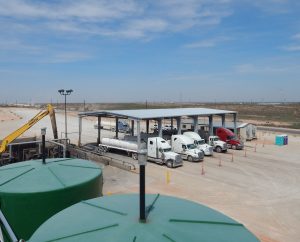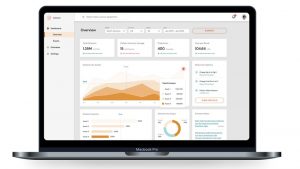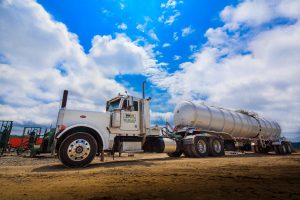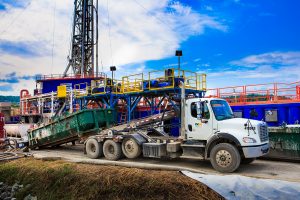One oilfield service sector that’s readily plugging in to increased planetary awareness is the environmental services niche. Two companies, Petro Waste (now under new ownership as described below) and Milestone Environmental Services, are among those who are growing their footprint. One whose footprint is already global—Halliburton—is hard at work developing software to make environmental impact tracking easier.
Changes for Petro Waste
In 2019 Petro Waste was purchased by Waste Management (now WM), a Houston-based company that operates trash collection services in many locations across the United States.
The company’s Area Manager for Energy Services Branden Styer said Petro Waste “is now an owned entity of WM Energy Services.” Their locations are all still branded as Petro Waste. The company owns five oil and gas landfills: two in the Midland Basin, one in Howard County near Big Spring, one in Big Lake, one in Orla, and the fifth is just south of Pecos. He also listed a landfill in Nordheim, Texas, near San Antonio, which services Eagle Ford companies. They also operate a number of saltwater disposal wells (SWDs).
Styer, who came to the oil and gas industry in 2010, said operators in 2023 are more focused on proper environmental operations than ever before. While in previous years some operators might have participated in unregulated burial of hazardous waste, that is no longer the case. And for Petro Waste and its parent company, compliance goes further than just safe burial.
“When you look at ESG and sustainability, we’ve been able to implement procedures that get a lot of lot of trucks off the road,” Styer said. They’ve done that by laying pipelines to transfer produced water from the field to SWDs instead of using trucks. The company’s first such SWD was at the Howard County site.
He continued, “With our number of our facilities, when you’re disposing of anywhere from 10,000 to 20,000 barrels of water a month and up, you’re getting 3-4-500 trucks off the road during the course of a month.”
He noted the company’s move to pipelines has reduced diesel use and road congestion, and has helped overcome the nationwide shortage of truck drivers. Petro Waste itself does not handle trucks or drivers, instead having created what Styer referred to as “partnerships or master service agreements [MSAs] with a number of trucking vendors” that are fully permitted and vetted.
From that they create call lists, which they use to find the next available provider any time solid waste hauling is needed.
Recycling Oil
In Howard County and in the Midland Basin, the company is also using a flotation process to collect and market any oil remaining in the produced water. “We’ve created a process where there are three streams,” he said. “There are solids, there’s water, and there’s oil.”
Incoming water sits in a pit for a time where the three components separate through a permitted process. Solids go to the landfill, oil is captured and marketed, then the much cleaner water goes into the SWD.
This checks two boxes, creating some income off the oil sold into the pipeline and cleaning the water being sent to the SWD, Styer noted.
With recent concerns about SWD seismicity, Styer said his company works with the Texas Railroad Commission to monitor that situation. Their best practices include closely monitoring injection pressures “and just really trying to stay focused on monitoring the pressures on our wells to make sure that we’re being a good steward.”
Future plans include investigating ways to reuse produced water in a number of ways, he said.
Plans
 Vertical integration—the ability to handle any kind of waste onsite, without issues of having to send it elsewhere—is a major push for the company, Styers noted. To that end they are in the process of adding an SWD to their South Texas facility—currently permitted, with construction planned to start in 2024—and all other facilities are “pipelined into current SWDs.” With the disposal space getting crowded, Styers said his company wants to be seen as a single stop for all types of oilfield disposal.
Vertical integration—the ability to handle any kind of waste onsite, without issues of having to send it elsewhere—is a major push for the company, Styers noted. To that end they are in the process of adding an SWD to their South Texas facility—currently permitted, with construction planned to start in 2024—and all other facilities are “pipelined into current SWDs.” With the disposal space getting crowded, Styers said his company wants to be seen as a single stop for all types of oilfield disposal.
Milestone Grows, Plans CCS
Milestone Environmental Services President and CEO Gabriel Rio also said the pandemic and its aftermath encouraged companies to be more environmentally oriented—and to be good neighbors. While environmental pressure has been mounting across recent decades, “The recent developments of the last few years have certainly felt different—they’ve moved faster in some ways.”
Based in Houston, Milestone operates nine facilities, including those in the Midland and Delaware basins, the Eagle Ford, and Haynesville. Rio said the company has added four new locations in the last three years, including their first one in New Mexico. The New Mexico facility opened in 2022.
One new concern involves carbon footprints, he said, including emissions of CO2 and methane. The new concerns are “starting to come more from the investment community,” whose influence he called profound. In response, Milestone has updated its outlook as well.
“On the carbon side, you have seen oil and gas companies [since 2020] making net zero commitments,” he said. In some cases the date is far in the future. But many have been followed up by action, he observed.
Although larger producers have overall led the way, Rio said it’s not a clear division between large and small. Some large producers are less actively engaged in net zero follow through than others, and many smaller producers are indeed on the way toward reducing their carbon footprints.
Because the producers were sometimes unsure of how to proceed, “We’ve had to do a few things to help them,” Rio said, referring to Milestone. “One, Milestone’s process is strongly carbon negative because we are taking some waste hydrocarbons that we can’t recover and putting them back under ground.” He explained that the company is taking hydrocarbons from the surface and returning them into underground formations.
Specifically, “Last year we sequestered about 450,000 tons of CO2 equivalent through our process across our network. It was not so much a matter of changing our operations as [it was] important for us to evaluate our carbon footprint, [and] quantify that,” he said. “It’s a process that is more complex than it might seem to make it consistent and auditable. Milestone reports those numbers to customers upon request, showing how much they reduced their carbon footprint using Milestone’s procedures.
On the good neighbor front, landowners are also demanding more care with oilfield waste. “I think part of that is because they [landowners] know that the operators have a different option,” [to be cleaner]. Many operators are actively pursuing cleaner options such as closed-loop drilling, which keeps all fluids in the system, without frac pits that need to be cleaned up after drilling is completed.
While closed-loop drilling is not required, as it is in California, some landowners have successfully pushed for the process in Texas and elsewhere, he said.
Noting the fact that environmental costs have come down in recent years is a boost for compliance, Rio said, “I think the old adage in the environmental space, that “everybody wants to do the right thing, when it comes to environmental protection and sustainability—as long as it’s cheaper,’ applies here.”
Recycling produced water is one example, where it’s cheaper to treat and reuse that water than to buy fresh, he said. Milestone works with water recycling companies by correctly disposing of the 10 percent of the water that contains the recycled water’s concentrated waste stream, he said.
Next Steps
Rio said Milestone is actively pursuing carbon capture and storage (CCS), planning to operate it as a separate venture. Called Milestone Carbon, plans are for it to “develop, build, and operate carbon sequestration infrastructure in a more traditional form” in addition to the disposing of unrecovered oil in SWDs. They will take CO2 from places like natural gas processing plants, fossil-fuel-fired power plants, and others at the point of emissions, then pipe them to owned and operated injection wells.
With complex issues such as permitting yet to be hurdled, Rio’s only current timetable for opening that service is listed as in the next few years.
Halliburton Recognizes Opportunity
With increasing focus on emissions management in every industry including the oil and gas sector, the need for a single-source means of assembling and evaluating those emissions is becoming more and more apparent. Tracking and evaluation methods vary across companies and, in many cases, across varied locations within companies, making data collection and standardization very challenging.
With that in mind, Halliburton recently announced that it and energy investment firm Siguler Guff were launching Envana Software Partners, LLC, to provide emissions management Software as a Service (SaaS) to oilfield companies.
The Birth of Envana
Envana’s Head of Product, Roxana Nielsen, described the creation of Envana’s service this way. “Halliburton’s Landmark Commercial Software team recognized that there was an opportunity in the sustainability space, where oil and gas companies did not have a good digital system for emissions management.”
In her then-role, the directorship of sustainability and stewardship at Halliburton, she was responsible for the company’s sustainability reporting and environmental and chemical regulation. As such it became apparent that there was no simple means of compiling and organizing all the pertinent data, then issuing a meaningful report. Collecting emails and spreadsheets across multiple departments was hugely time consuming.
So after energizing her team on this issue, she said, “There was an effort to incubate product, and that’s really how Envana was born.”
Because the creative team came from the oil and gas sector, Nielsen said they uniquely understood the needs of the industry. Added Paul Hajek, the director of sales for Envana, “Our product is designed to cover the full E&P life cycle and so we give a more comprehensive overview and reporting.” That coverage extends from drilling, through production, all the way to plugging, abandonment, and decommissioning.
The Goal
Most existing software required extensive manual gathering and compiling from disparate sources, in many cases both manual and software-based. The time required for this laborious process made it “after the fact, retroactive,” said Nielsen. There were also endless standards and methods for calculating emissions, creating more issues. And larger companies operating in multiple states and regions could face varying and even conflicting regulatory/reporting requirements.
“Being able to forecast and project what your emissions will be will help you understand whether you’re on track to meet reduction targets or not, or whether you’re going to exceed them,” she pointed out.
She continued, “So having a system that makes it easier by consolidating everything and managing all the different requirements that you have to report is really what Envana is trying to do.” The firm’s first SaaS product is called Catalyst.
In the creation process, the team understood that the list of potential end users would be all over the map regarding their tracking and reporting levels—some with extensive tracking and reporting systems in place, others with little more than a vague feeling that they should be reporting something. Therefore, with any new client the team learns the needs and tailors the system appropriately.
Specific goals, said Nielsen, are as follows:
1 To help companies understand, at the operations level, how their business operations are creating emissions (Scope One, Two and Three)
2 To help them prioritize how to tackle emissions reduction and
3 How to communicate their efforts to investors, employees, and the public.
Reception in the Marketplace
As to how Envana Catalyst has been received, Hajek pointed out that today’s E&P companies are getting more invested in this kind of tracking and reporting due to interest from investors and the public—and even small to medium companies are getting on board. As stated previously, “There’s quite a lot to manage, so when we come ready out-of-the-box to be able to handle that, especially for scopes one, two and three, it’s definitely a welcome addition.” Not to mention a solution to tracking and reporting issues. The fact that Catalyst came from an experienced group of oil and gas professionals also helped, he said.
As the software matures Nielsen and Hajek expect Envana to grow their product offerings and to incorporate artificial intelligence in expanding its capabilities.
Paul Wiseman is an energy freelance writer. His email address is fittoprint414@gmail.com.











